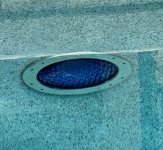I don’t think there are any stupid questions, but some are tougher to answer in a complete way. I’m hoping to get more thoughts from TFP folks like
@mas985,
@ajw22, and others on this topic of light safety, mostly
because there seem to be a hundred or so similar low voltage light replacement offerings on amazon and elsewhere and I have a few concerns…
- I saw one listing that reads “We understand your safety concerns, that’s why our lights are 12 volt”. We know there is much more to pool electrical safety than willy-nilly “installing 12 volt stuff”. NEC Article 680 outlines all the requirements to minimize the likelihood of injuring ourselves and family members.
- Another listing reads “ensure the ground is boded”. Yes, misspelling “bonded” and conflating bonding with grounding, two entirely different and critically important aspects of the installation and pool electrical safety. For me it sheds some light on how much care is placed on design, safety and documentation.
- Something to watch for, and perhaps my biggest concern is that many or most offerings fail to state the transformer is UL listed for pool use. Some (not many) state “UL Listed” but you can’t tell specifically about the transformer. It’s tough to know before buying, but it seems to me NEC 680.23(A)(2) states: Transformers and power supplies for underwater luminaires must be listed, labeled, and identified for swimming pool use. Did I miss a change that allows almost any (plastic-encased) transformer to be used for a pool light? Are we now treating the transformers as in Article 411 as if they are just low voltage landscape lighting systems?
- Thankfully, most of the offerings seem to specify a GFCI breaker on the primary so we can be hopeful at least that transformer leakage or other faults are interrupted if that GFCI is indeed employed (and regularly tested).
- Am I overthinking it? Does the topic belong in “The Deep End” forum? Or maybe I should post the transformer question to Mike Holt’s forum.
Moving on to specifics about the OP (Original Post): I did help a neighbor and his licensed electrician install a very similar light in his pool, and the installation is essentially as stated in the OP. My role mostly involved spending over an hour (w/mask & snorkel) working the old screw back and forth out of the ring of the wet niche to release the old luminaire housing. Over the years calcium builds up on the screw and it can be a bear working it slowly out so it doesn’t break off. If it breaks I guess you partially drain the pool so it can be drilled out. The transformer got mounted on a wall by the equipment pad, the new wire cord run through existing rigid PVC conduit to a properly located and elevated junction box outside the pool area. #8 bonding wire was complete from other pool equipment to the junction box, then on to the wet niche housing – a non-conductive niche in this case but with a bonding strap to ensure the metal ring of the new light was bonded via the new screw. The light worked and user is happy, although I had the subjective opinion that it’s a bit dim. Amazon flags the unit in the OP as “a frequently returned item”. Watch for compatibility with your wet niche, and some of the offerings feature an adjustable tab at the 6 o’clock position to accommodate niche variations so the new light “catches” and mounts in a solid way. Most offer a tab that is not adjustable and I can’t find the exact adjustable one my neighbor used. Also, a 12 volt 500 watt light was noted in the OP – is there such a thing? My experience is limited, but that would be 42 amps. It just made me wonder if all of those lights in your 20,000 gallon pool are truly 12 volt, so caution advised. If following aforementioned NEC 680 requirements, the suggestion to start by replacing just one light seems like a good idea. The offering says one controller can run multiple lights, implying another junction box in an appropriate place with all the same location, bonding and grounding requirements.
Summary advice: Hire a licensed electrician experienced with pool equipment and who is well versed in NEC Article 680. And continue to educate ourselves on pool electrical safety through materials such as this basic
Pool School Guide, also in
Electrical Bonding - Further Reading and this great Mike Holt
Video. All those have many links to deeper dives.
My experience with LED’s of all kinds, cheap or expensive, whether little 12v ones or larger 120v ones, matches what
@reggiehammond wrote. Whether I get the cheapest or the best name brands, I tend to get about 3,000 to 6,000 hours from them (often less), not the 20,000-plus hours often advertised. And some get dimmer or flicker over their life. I wind up replacing pool LEDs every year or two since I have them on whenever it’s dark and I’m awake – loving the look!




